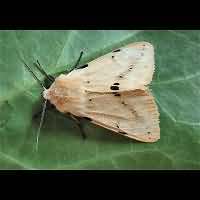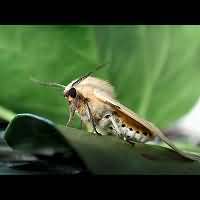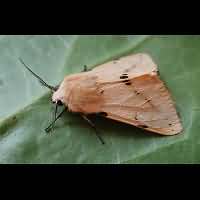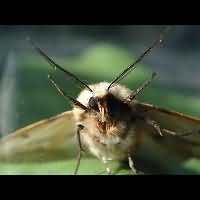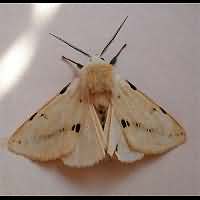Buff Ermine (Spilosoma lutea)
The Buff Ermine is a hairy moth with a variable pastel colour. Females are creamy white and males may be yellowish or buff. Usually there are a few variable black spots on the front edge of the front wing. Other black dots often represent an interupted line of black running from just before the tip of the wing to just before the middle of the wing. There may be other black dots as well. But all dots vary both in intensity of the black and in size. Almost undotted animals also appear regularly. The Buff Ermine often looks like the White Ermine, the Water Ermine and the female of the Muslin Moth. However the White Ermine is slightly whiter, a bit bigger and lacks the stright line of dots. The Water Ermine always is snowy white and never creamish or buff. The female of the Muslin Moth has no markings whatsoever on the underwings. The Buff Ermine always has at least one black dot there and usually even two. The wingspan is somewhere between 34 and 42 mm.
The eggs are deposited in large groups in summer. They hatch quickly, the caterpillars eat a lot and grow fast. Young larvae of the Buff Ermine often live together in large groups, but they split up once older. The larvae are extremely mobile and capable of covering large distances quickly, especially during the last instar. When threatened the caterpillars either freeze or run away quickly. In autumn greyish black cocoons are wooven in which pupation takes place. The cocoons can be found among leaflitter and other plant debris during winter. The caterpillar of the Buff Ermine is greyish brown. A whitish brown, thin line runs over the back and two additional whitish brown lines over the sides. The long hairs are yellowish brown growing from light brown warts. The head is light brown. The caterpillar reaches a maximum length of some 45 mm. They'll eat almost everything: from small garden plants to shrubs and trees (birch).
Even though the first Buff Ermines appear in April and the last are seen by the end of August, most fly about from mid-June to mid-July. The animal only flies during the night. Should you find one resting during the day, you can easily take some pictures as it hardly ever moves and never flies off. This is probably due to the fact that both adult and larva are foul tasting and even slightly poisonous for birds. Adult moths do not eat. Both males and females come to light readily. A very common and sometimes even numerous species all over Britain. Also very common on the continent.
The scientific name of this species is wrongly also written as Spilosoma luteum.
The Buff Ermine is a hairy moth with a variable pastel colour. Females are creamy white and males may be yellowish or buff. Usually there are a few variable black spots on the front edge of the front wing. Other black dots often represent an interupted line of black running from just before the tip of the wing to just before the middle of the wing. There may be other black dots as well. But all dots vary both in intensity of the black and in size. Almost undotted animals also appear regularly. The Buff Ermine often looks like the White Ermine, the Water Ermine and the female of the Muslin Moth. However the White Ermine is slightly whiter, a bit bigger and lacks the stright line of dots. The Water Ermine always is snowy white and never creamish or buff. The female of the Muslin Moth has no markings whatsoever on the underwings. The Buff Ermine always has at least one black dot there and usually even two. The wingspan is somewhere between 34 and 42 mm.
The eggs are deposited in large groups in summer. They hatch quickly, the caterpillars eat a lot and grow fast. Young larvae of the Buff Ermine often live together in large groups, but they split up once older. The larvae are extremely mobile and capable of covering large distances quickly, especially during the last instar. When threatened the caterpillars either freeze or run away quickly. In autumn greyish black cocoons are wooven in which pupation takes place. The cocoons can be found among leaflitter and other plant debris during winter. The caterpillar of the Buff Ermine is greyish brown. A whitish brown, thin line runs over the back and two additional whitish brown lines over the sides. The long hairs are yellowish brown growing from light brown warts. The head is light brown. The caterpillar reaches a maximum length of some 45 mm. They'll eat almost everything: from small garden plants to shrubs and trees (birch).
Even though the first Buff Ermines appear in April and the last are seen by the end of August, most fly about from mid-June to mid-July. The animal only flies during the night. Should you find one resting during the day, you can easily take some pictures as it hardly ever moves and never flies off. This is probably due to the fact that both adult and larva are foul tasting and even slightly poisonous for birds. Adult moths do not eat. Both males and females come to light readily. A very common and sometimes even numerous species all over Britain. Also very common on the continent.
The scientific name of this species is wrongly also written as Spilosoma luteum.

